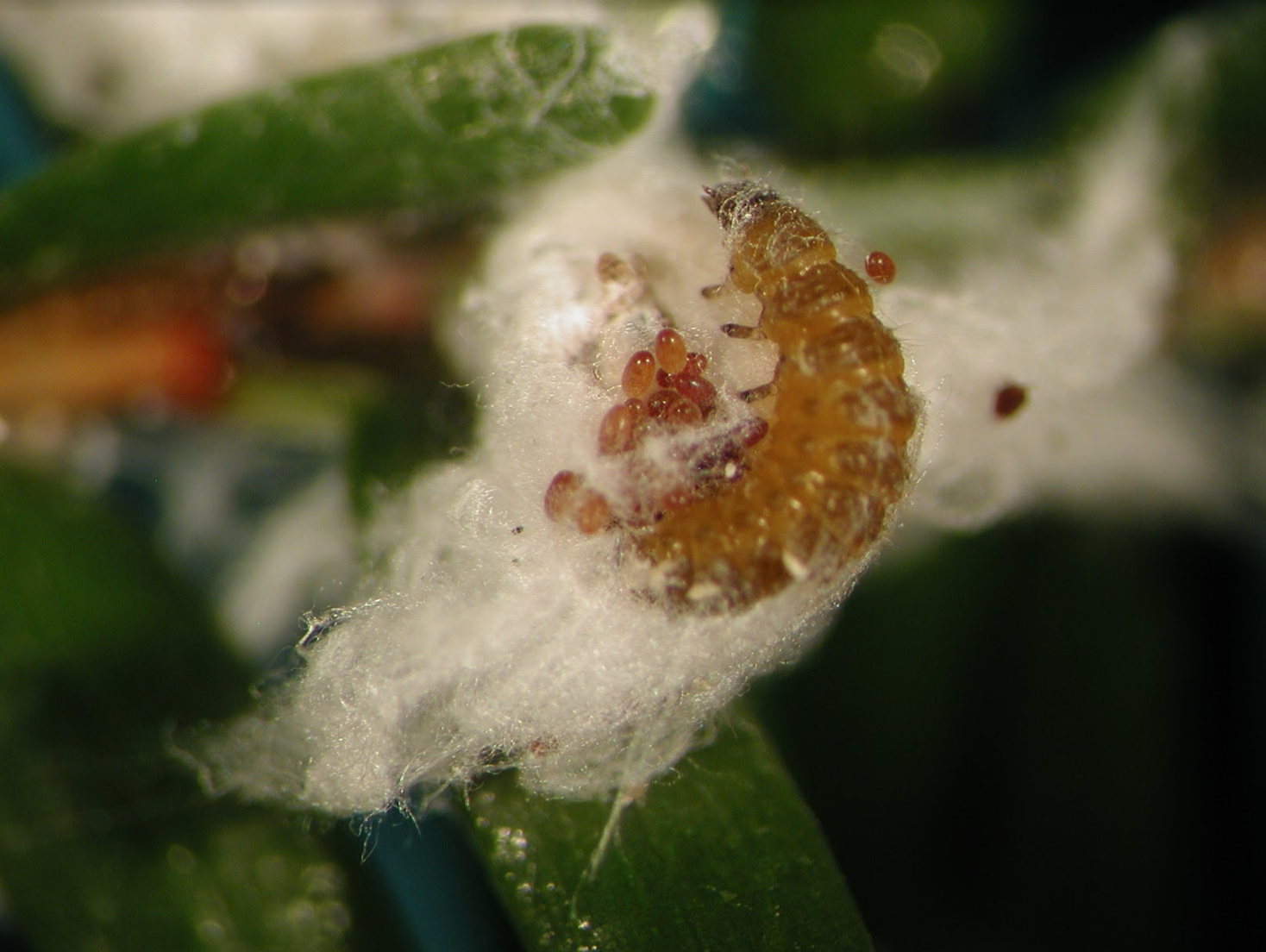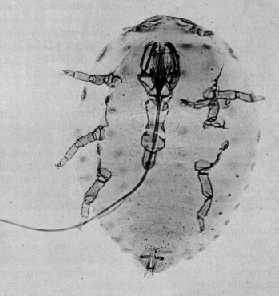|
Laricobius Nigrinus
''Laricobius nigrinus'' is a species of tooth-necked fungus beetle in the family Derodontidae. It is native to western North America, and it is being studied as a biological control agent for the hemlock woolly adelgid. It was first released in 2003 and continues to be reared and released across the Northeast to control infestations. Taxonomy ''Laricobius nigrinus'' was first described by Kenneth Fender in 1945 from specimens collected in Oregon. ''Laricobius'' is one of four genera in Derodontidae. The genus has a Holarctic distribution, with most species native to Asia. Description Adult beetles have a black body, clubbed antennae with eleven segments, and two ocelli. Their palps, antennae, and tarsi are dark brown to red. The head is partially visible from above. They are usually 2.3-2.9 mm long, with no significant sex differences in size. The species can be distinguished from other black ''Laricobius'' by its toothed pronotal margin. Its eggs are yellow and oblong ... [...More Info...] [...Related Items...] OR: [Wikipedia] [Google] [Baidu] |
Laricobius Nigrinus Larva Feeding
''Laricobius'' is a genus of beetles in the family Derodontidae, the tooth-necked fungus beetles.''Laricobius''. Integrated Taxonomic Information System (ITIS) It is one of four genera in the family. While the other three feed on , ''Laricobius'' species feed on adelgids, tiny insects very similar to aphids.Montgomery, M. E., et al. (2011) [...More Info...] [...Related Items...] OR: [Wikipedia] [Google] [Baidu] |
Tooth-necked Fungus Beetle
Derodontidae is a family of beetles, in its own superfamily, Derodontoidea, sometimes known as the tooth-necked fungus beetles. Beetles of this family are small, between 2 and 6 mm in length, typically with spiny margins on their pronotum (part of the thorax) that give them their name, though the genus ''Laricobius'' lacks these spines. Unusual among beetles, they have two ocelli on the top of their heads. They are related to the Bostrichoidea, which includes the death watch beetles, skin beetles, powder-post beetles and other subgroups. Some species feed on slime molds, but the larvae and adults of the genus ''Laricobius'' are predators of woolly adelgids which attack conifers, and species of this genus are used as biological control agents in the United States for control of balsam woolly adelgid and hemlock woolly adelgid. There are 42 species in 4 genera and 3 subfamilies. The family includes: *Subfamily Derodontinae **Genus ''Derodontus'' (11 species) *Subfamily Laric ... [...More Info...] [...Related Items...] OR: [Wikipedia] [Google] [Baidu] |
Derodontidae
Derodontidae is a family of beetles, in its own superfamily, Derodontoidea, sometimes known as the tooth-necked fungus beetles. Beetles of this family are small, between 2 and 6 mm in length, typically with spiny margins on their pronotum (part of the thorax) that give them their name, though the genus ''Laricobius'' lacks these spines. Unusual among beetles, they have two ocelli on the top of their heads. They are related to the Bostrichoidea, which includes the death watch beetles, skin beetles, powder-post beetles and other subgroups. Some species feed on slime molds, but the larvae and adults of the genus ''Laricobius'' are predators of woolly adelgids which attack conifers, and species of this genus are used as biological control agents in the United States for control of balsam woolly adelgid and hemlock woolly adelgid. There are 42 species in 4 genera and 3 subfamilies. The family includes: *Subfamily Derodontinae **Genus ''Derodontus'' (11 species) *Subfamily La ... [...More Info...] [...Related Items...] OR: [Wikipedia] [Google] [Baidu] |
Biological Control
Biological control or biocontrol is a method of controlling pests, such as insects, mites, weeds, and plant diseases, using other organisms. It relies on predation, parasitism, herbivory, or other natural mechanisms, but typically also involves an active human management role. It can be an important component of integrated pest management (IPM) programs. There are three basic strategies for biological pest control: classical (importation), where a natural enemy of a pest is introduced in the hope of achieving control; inductive (augmentation), in which a large population of natural enemies are administered for quick pest control; and inoculative (conservation), in which measures are taken to maintain natural enemies through regular reestablishment. Natural enemies of insect pests, also known as biological control agents, include predators, parasitoids, pathogens, and competitors. Biological control agents of plant diseases are most often referred to as antagonists. Biologic ... [...More Info...] [...Related Items...] OR: [Wikipedia] [Google] [Baidu] |
Hemlock Woolly Adelgid
The hemlock woolly adelgid (; ''Adelges tsugae''), or HWA, is an insect of the order Hemiptera (true bugs) native to East Asia. It feeds by sucking sap from hemlock and spruce trees (''Tsuga'' spp.; ''Picea'' spp.). In its native range, HWA is not a serious pest because populations are managed by natural predators and parasitoids and by host resistance. In eastern North America it is a destructive pest that threatens the eastern hemlock (''Tsuga canadensis'') and the Carolina hemlock (''Tsuga caroliniana''). HWA is also found in western North America, where it has likely been present for thousands of years. In western North America, it primarily attacks western hemlock ''Tsuga heterophylla'' and has only caused minor damage due to natural predators and host resistance. Accidentally introduced to North America from Japan, HWA was first found in the eastern United States near Richmond, Virginia, in 1951. The pest is now found from northern Georgia to coastal Maine and southwest ... [...More Info...] [...Related Items...] OR: [Wikipedia] [Google] [Baidu] |
Adelgidae
The Adelgidae are a small family of the Hemiptera closely related to the aphids, and often included in the Aphidoidea with the Phylloxeridae or placed within the superfamily Phylloxeroidea as a sister of the Aphidoidea within the infraorder Aphidomorpha. The family is composed of species associated with pine, spruce, or other conifers, known respectively as "pine aphids" or "spruce aphids". This family includes the former family Chermesidae, or "Chermidae", the name of which was declared invalid by the International Commission on Zoological Nomenclature, ICZN in 1955. There is still considerable debate as to the number of genera within the family, and the classification is still unstable and inconsistent among competing authors. There are about fifty species of adelgids known. All of them are native to the northern hemisphere, although some have been introduced to the southern hemisphere as invasive species. Unlike aphids, the adelgids have no tail-like Cauda (other), c ... [...More Info...] [...Related Items...] OR: [Wikipedia] [Google] [Baidu] |
Univoltine
Voltinism is a term used in biology to indicate the number of broods or generations of an organism in a year. The term is most often applied to insects, and is particularly in use in sericulture, where silkworm varieties vary in their voltinism. * Univoltine (monovoltine) – (adjective) referring to organisms having one brood or generation per year * Bivoltine (divoltine) – (adjective) referring to organisms having two broods or generations per year *Trivoltine – (adjective) referring to organisms having three broods or generations per year * Multivoltine (polyvoltine) – (adjective) referring to organisms having more than two broods or generations per year * Semivoltine – There are two meanings: :* (''biology'') Less than univoltine; having a brood or generation less often than once per year :* or (adjective) referring to organisms whose generation time is more than one year. Examples The speckled wood butterfly is univoltine in the northern part of its range, e.g. north ... [...More Info...] [...Related Items...] OR: [Wikipedia] [Google] [Baidu] |
Aestivation
Aestivation ( la, aestas (summer); also spelled estivation in American English) is a state of animal dormancy, similar to hibernation, although taking place in the summer rather than the winter. Aestivation is characterized by inactivity and a lowered metabolic rate, that is entered in response to high temperatures and arid conditions. It takes place during times of heat and dryness, the hot dry season, which are often the summer months. Invertebrate and vertebrate animals are known to enter this state to avoid damage from high temperatures and the risk of desiccation. Both terrestrial and aquatic animals undergo aestivation. Fossil records suggest that aestivation may have evolved several hundred million years ago. Physiology Organisms that aestivate appear to be in a fairly "light" state of dormancy, as their physiological state can be rapidly reversed, and the organism can quickly return to a normal state. A study done on '' Otala lactea'', a snail native to parts of Eu ... [...More Info...] [...Related Items...] OR: [Wikipedia] [Google] [Baidu] |
Congener (biology)
Biological specificity is the tendency of a characteristic such as a behavior or a biochemical variation to occur in a particular species. Biochemist Linus Pauling stated that "Biological specificity is the set of characteristics of living organisms or constituents of living organisms of being special or doing something special. Each animal or plant species is special. It differs in some way from all other species...biological specificity is the major problem about understanding life." Biological specificity within ''Homo sapiens'' ''Homo sapiens'' has many characteristics that show the biological specificity in the form of behavior and morphological traits. Morphologically, humans have an enlarged cranial capacity and more gracile features in comparison to other hominins. The reduction of dentition is a feature that allows for the advantage of adaptability in diet and survival. As a species, humans are culture dependent and much of human survival relies on the culture and so ... [...More Info...] [...Related Items...] OR: [Wikipedia] [Google] [Baidu] |
Laricobius Rubidus
''Laricobius rubidus'' is a species of tooth-necked fungus beetle in the family Derodontidae. It is found in North America. Studies are ongoing to determine the rate of hybridization between ''L. rubidus'', which feeds on pine bark adelgid, and its native congener, '' Laricobius nigrinus'', which is being studied as a biological control agent for the hemlock woolly adelgid The hemlock woolly adelgid (; ''Adelges tsugae''), or HWA, is an insect of the order Hemiptera (true bugs) native to East Asia. It feeds by sucking sap from hemlock and spruce trees (''Tsuga'' spp.; ''Picea'' spp.). In its native range, HWA .... References Further reading * Derodontidae Articles created by Qbugbot Beetles described in 1861 {{polyphaga-stub ... [...More Info...] [...Related Items...] OR: [Wikipedia] [Google] [Baidu] |
Articles Created By Qbugbot
Article often refers to: * Article (grammar), a grammatical element used to indicate definiteness or indefiniteness * Article (publishing), a piece of nonfictional prose that is an independent part of a publication Article may also refer to: Government and law * Article (European Union), articles of treaties of the European Union * Articles of association, the regulations governing a company, used in India, the UK and other countries * Articles of clerkship, the contract accepted to become an articled clerk * Articles of Confederation, the predecessor to the current United States Constitution *Article of Impeachment, a formal document and charge used for impeachment in the United States * Articles of incorporation, for corporations, U.S. equivalent of articles of association * Articles of organization, for limited liability organizations, a U.S. equivalent of articles of association Other uses * Article, an HTML element, delimited by the tags and * Article of clothing, an i ... [...More Info...] [...Related Items...] OR: [Wikipedia] [Google] [Baidu] |
Beetles Described In 1945
Beetles are insects that form the order Coleoptera (), in the superorder Endopterygota. Their front pair of wings are hardened into wing-cases, elytra, distinguishing them from most other insects. The Coleoptera, with about 400,000 described species, is the largest of all orders, constituting almost 40% of described insects and 25% of all known animal life-forms; new species are discovered frequently, with estimates suggesting that there are between 0.9 and 2.1 million total species. Found in almost every habitat except the sea and the polar regions, they interact with their ecosystems in several ways: beetles often feed on plants and fungi, break down animal and plant debris, and eat other invertebrates. Some species are serious agricultural pests, such as the Colorado potato beetle, while others such as Coccinellidae (ladybirds or ladybugs) eat aphids, scale insects, thrips, and other plant-sucking insects that damage crops. Beetles typically have a particularly hard exoske ... [...More Info...] [...Related Items...] OR: [Wikipedia] [Google] [Baidu] |





